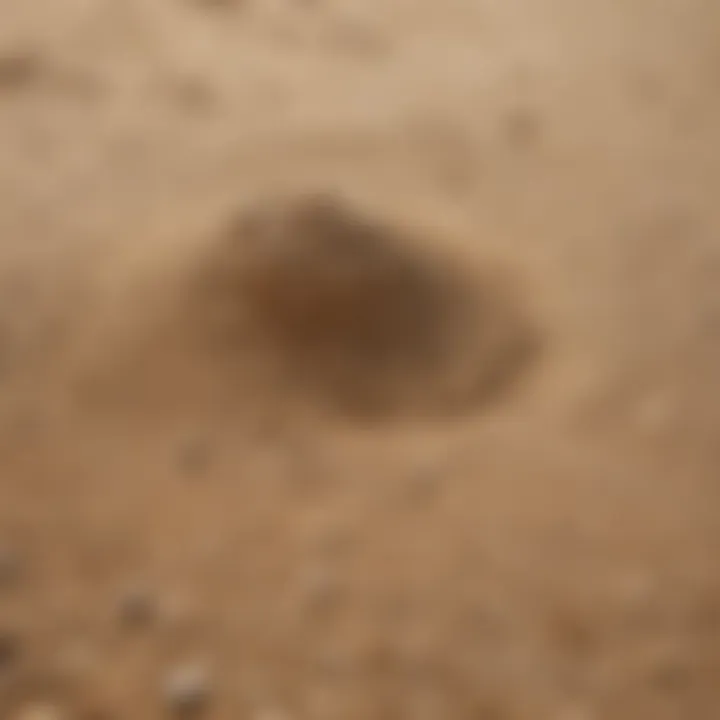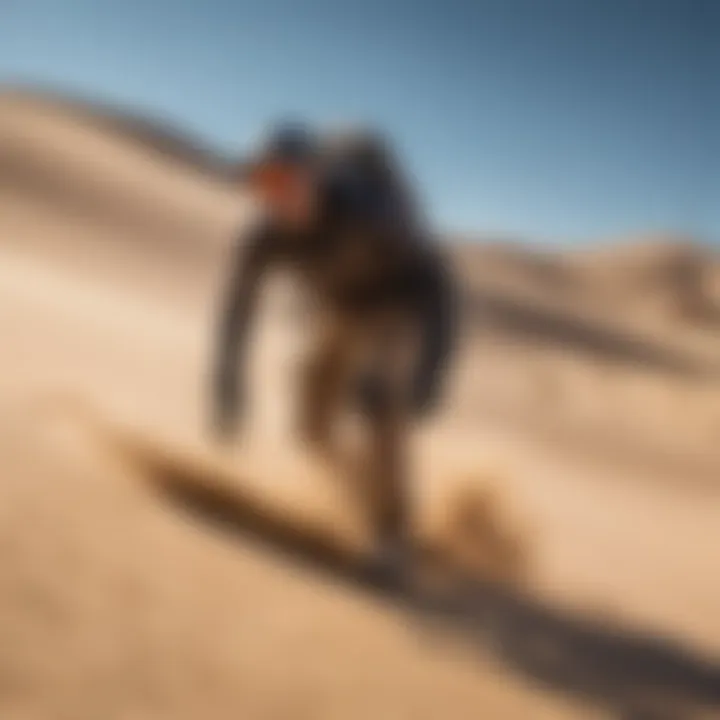Understanding Sand Hardness for Extreme Sports


Intro
In the realm of extreme sports, the significance of sand hardness cannot be overstated. For enthusiasts engaged in activities such as sandboarding and beach racing, understanding the implications of various types of sand plays a critical role in both performance and safety. Sand hardness is influenced by factors such as moisture content, grain size, and compactness, all of which affect how athletes navigate sandy terrains. This article delves deep into these elements, providing insights and practical tips for both seasoned athletes and novices alike.
The journey begins by exploring the very nature of extreme sports, defining what sets them apart from traditional sports and examining their evolution over time. Following this foundation, we will shift focus to the critical gear and equipment necessary for thriving in sandy environments. Safety considerations will be woven throughout, ensuring participants are well-equipped to handle the unique challenges posed by soft or shifting sands.
Physical and mental preparation techniques follow, as they are paramount for athletes looking to achieve optimal performance. Key training regimens will be discussed to help individuals prepare adequately for their adventures. Finally, we will list some of the top destinations famous for extreme sand sports, providing valuable travel tips for those adventurous souls eager to explore diverse sandy landscapes.
Ultimately, this article seeks to furnish readers with a holistic understanding of sand hardness and its implications for extreme sports, enabling better preparation and enriched experiences in these thrilling activities.
Intro to Sand Hardness
Sand hardness refers to the physical attributes of sand that define its resistane to compression and deformation. This concept is especially significant in the context of extreme sports, where the surface on which athletes perform is critical to their overall experience and performance. The type of sand, its texture, and consistency can greatly influence the safety and flow of sports such as sandboarding or sand kiting.
When discussing sand hardness, we need to consider the interplay between various factors such as moisture content, grain size, and environmental influences. Athletes, whether seasoned or beginners, must understand these elements. Knowledge of sand hardness not only aids in performance optimization but also enhances risk management.
Furthermore, understanding the characteristics of sand can lead athletes to better choose their locations for practice and competition. Injuries can often be attributed to sandy terrain not being well understood. This aspect adds depth to both preparation and execution during sports activities.
Defining Sand Hardness
Defining sand hardness involves looking closely at the granulometry and physical properties of sand particles. Hardness indicates how well the sand can support weight without compacting significantly. The composition of sand consists of various minerals, with quartz being a common one, affecting its hardness.
The hardness is also evaluated based on its resistance to pressure. Harder sands offer a firmer grip for athletes, while softer sands may yield more, affecting balance and speed.
Hardness can also be described through its cohesive properties. For example, wet sand tends to be harder, as moisture binds the particles together.
Importance in Extreme Sports
The relevance of sand hardness in extreme sports cannot be overstated. Athletes rely on specific sand conditions for optimal performance. Whether it is the agility required in sandboarding or the endurance needed for running on the beach, the resistance offered by the sand surface is a critical factor.
A few points to consider include:
- Performance: The hardness affects speed, control, and the ability to execute tricks.
- Safety: Softer sand might be more forgiving, but it can lead to unexpected falls or loss of control.
- Training: Athletes can tailor their training regimens based on the hardness of training surfaces.
Ultimately, understanding sand hardness is not just about enhancing performance but also about ensuring safety. Athletes who pay attention to these details stand to gain an advantage in both competitions and personal challenges.
Factors Influencing Sand Hardness
Understanding the factors influencing sand hardness is crucial for anyone involved in extreme sports. The degree of hardness can significantly affect performance, safety, and the overall experience in sandy environments. These factors include moisture content, grain size and shape, and environmental considerations. Each of these elements contributes to not only the characteristics of the sand but also how athletes interact with it during sports activities.
Moisture Content
Moisture content plays a vital role in determining sand hardness. When sand is dry, it generally tends to be less compact and more loose, making it challenging for athletes to maintain speed and control. In contrast, when there is sufficient moisture in the sand, it tends to stick together, creating a firmer surface that can significantly enhance performance.
Athletes must consider local weather patterns before engaging in activities like sandboarding. Wet sand provides better traction, allowing for more speed without the risk of sinking too deep. However, if the sand is too wet, it might become muddy and impair movement. Thus, understanding local conditions can provide an advantage in performance.
Grain Size and Shape
The size and shape of sand grains also decisively influence hardness. Larger grains tend to create a coarser surface, often leading to a less stable footing. Conversely, finer grains can compact more tightly, resulting in a sturdy surface. Furthermore, round grains roll more easily, making it difficult for athletes to gain control, while angular grains lock together better, providing a more stable base.
Athletes should evaluate the grain characteristics of their chosen location. Ideally, conditions that offer various grain sizes can benefit different skills and techniques, allowing each athlete to excel based on personal preferences.
Environmental Considerations
Environmental factors also shape sand hardness. Elements such as wind and temperature can alter the consistency of sand over time. High winds can lead to loose, unstable surfaces, posing serious risks to athletes. Seasonal changes can also affect moisture content and sand structure, resulting in varying conditions from one season to another.
Athletes must stay informed about local environments. Understanding these variations helps maximize performance while reducing risks. Knowledge of the area's specific climate conditions aids in preparation, ultimately enhancing the overall experience in extreme sports involving sand.
"Harnessing knowledge of sand conditions can greatly elevate performance and safety in extreme sports."


By recognizing these factors, athletes and enthusiasts can adapt their techniques better to the conditions at hand. This information allows for smarter planning and ultimately leads to a more enjoyable and successful experience in extreme sports.
Impact of Sand Hardness on Performance
Understanding the impact of sand hardness on performance is crucial for athletes involved in extreme sports such as sandboarding and dune racing. The hardness of sand directly correlates with how athletes can maneuver, accelerate, and maintain stability while engaging in their activities. Soft sand may cushion falls but can also lead to sluggish movements and reduced speed. Conversely, harder sand often allows for better grip and faster performance.
When athletes choose locations for their sports, the condition of the sand plays an essential role in how they perform. Factors such as moisture content, grain size, and environmental aspects can vary greatly, making some sandy terrains more suitable than others.
Being aware of these nuances can greatly improve both individual performance and overall enjoyment of the activity. Athletes can adapt their techniques and choose their gear based on the sand conditions, ensuring they optimize their experience in sandy environments.
Effects on Speed and Control
The relationship between sand hardness and speed is quite significant. Harder sand provides a firmer base, enabling athletes to reach higher speeds due to less energy being absorbed by the surface. This characteristic allows for quicker starts and sharper turns, which are vital in sandboarding.
On the other hand, soft sand can slow athletes down. The deeper they sink into the sand, the less control they feel. Soft sand can create an unpredictable surface that undermines balance and stability. Athletes often find themselves exerting more energy to maintain control in these conditions. Thus, it is essential for athletes to evaluate the sand conditions at their chosen venue.
"The nature of the sand beneath your feet can make the difference between a thrilling ride and a frustrating slog."
To maximize performance, athletes should consider the following:
- Evaluate sand hardness before attempting any runs or races.
- Use equipment tailored for either soft or hard sand surfaces.
- Practice agility drills that enhance control and balance, especially in softer conditions.
Impact on Athlete Endurance
Athlete endurance is another crucial element influenced by sand hardness. In softer sand, athletes expend more energy as they work harder to navigate the terrain. This can lead to quicker fatigue, limiting total performance time. As the body tires, reaction time slows, which can result in missed opportunities for maneuvers or stunts.
Conversely, performing in harder sand typically allows for more efficient movement. Athletes can maintain a steady pace with less effort, conserving energy for more extended periods or for executing complex moves. Thus, the condition of the sand directly influences how long an athlete can last in an event.
For optimal performance:
- Choose your location wisely. Assess sand conditions to match your skill level and objectives.
- Train effectively. Focus on building stamina and strength to handle varying sand conditions.
- Rest adequately before events, especially when navigating soft or dynamic sand.
By understanding these aspects of sand hardness, athletes can refine their skills and ensure they are not only performing well but also enjoying their experience to the fullest.
Choosing Locations for Sand Sports
Choosing the right locations for sand sports is fundamental for maximizing performance and ensuring safety. The quality of the sand directly affects how athletes can navigate their activities, making this a critical consideration for extreme sports enthusiasts. Locations should not only provide an exhilarating experience but also present a manageable environment that aligns with the athletes’ skills and objectives.
Evaluating Sand Conditions
When evaluating any site for sand sports, it’s essential to assess the sand conditions. Athletes should analyze the hardness, moisture content, and grain size before engaging in any activity. Hard sand is better for speed and control, while soft and loose sand can cause fatigue and hinder performance.
Some specific factors to consider include:
- Moisture levels: Wet sand tends to be more compact and stable.
- Grain composition: Larger grains often yield more resistance, so a mix is generally preferable.
- Site layout: Slopes and obstacles should be noted for safety.
"The right conditions can make all the difference between a thrilling experience and a frustrating one."
By carefully evaluating these conditions, athletes can optimize their performance and enjoy their sport more fully.
Popular Sandboarding Destinations
There are several world-renowned destinations that cater to sandboarding enthusiasts. Each site presents distinct characteristics based on local sand conditions, climate, and terrain. Well-known locations include:
- Dune de Pilat, France: Renowned for its high dunes and variety of slopes.
- Cerro Blanco, Peru: Famous for its vast sandy landscapes and challenging dunes.
- Huacachina Oasis, Peru: Known for its picturesque scenery and exciting sandboarding opportunities.
- Big Dune, Namibia: Offers some of the highest sand dunes in the world, providing a thrilling experience.
These destinations not only provide exceptional sand conditions for sport but also breathtaking environments.
Environmental Regulations
When participating in sand sports, it is vital to be aware of environmental regulations. Various locations may have specific rules to protect sensitive ecosystems. For example, off-road access might be restricted in certain areas to preserve wildlife habitats and vegetation. Athletes should:


- Research local laws: Understanding regulations about where and when you can participate is crucial.
- Practice sustainability: Make sure to respect the environment. Avoid damaging flora and fauna during activities.
- Consider permits: Some areas may require a permit for sand sports activities. Obtaining these in advance can prevent fines.
By following these guidelines, athletes not only ensure their safety but also help to maintain the natural beauty of their chosen destinations.
Equipment and Gear for Sand Sports
The role of equipment and gear in sand sports cannot be overstated. Having the right tools not only enhances performance but also helps in ensuring safety during extreme activities. Properly selected equipment is crucial for optimizing your experience while participating in sandboarding and other sandy pursuits. This section will break down the essential elements that every enthusiast should consider when gearing up for an adventure in sandy environments.
Choosing the Right Board
Selecting the right board is fundamental for any sand sport. Different boards are designed for various skill levels, terrain conditions, and personal preferences. For instance, sandboards vary in size, shape, and construction materials. Choosing too short or too long a board can lead to difficulties in control, which may negatively affect performance.
When assessing a board, consider the following factors:
- Size: A longer board can provide better stability at high speeds, while a shorter board can improve maneuverability.
- Shape: Some boards have a wider nose for improved buoyancy in soft sand, while others have a tapered design for added speed.
- Material: Durable materials like polyethylene resist abrasion and increase the board's lifespan, while lighter materials can enhance performance.
Additionally, trying out various boards can help locate the one that aligns best with your style and the specific conditions of your chosen location. Ensuring that your board is well-maintained is also key. Check for defects and keep the bottom clean for optimal sliding capabilities.
Safety Gear Recommendations
Safety gear is indispensable for anyone engaging in sand sports. The unpredictable nature of sandy terrains can lead to injuries if precaution is not taken. Therefore, incorporating proper safety equipment is a wise approach.
Recommended safety gear includes:
- Helmet: A well-fitted helmet protects the head from impacts, which can occur during falls or collisions.
- Wrist Guards: These are essential for preventing injuries to the wrists, especially in high-speed scenarios.
- Knee and Elbow Pads: These pads provide extra cushioning, reducing the risk of abrasions and injuries during tumbles.
- Sunscreen and Protective Clothing: Extended exposure to the sun is a concern in sandy environments. Proper clothing and sunscreen protect against harmful UV rays, ensuring skin health.
Investing in quality safety gear not only protects the athlete but also enhances overall performance. Feeling secure allows individuals to focus on their skills without the worry of injuries.
Training Techniques for Sand Performance
Training effectively for sand performance requires a focused approach. The shifting, unpredictable surface of sand presents unique challenges compared to traditional terrains. Therefore, adopting specific training techniques is vital for maximizing performance in sandy environments, particularly for extreme sports. These techniques not only enhance physical capability but also improve mental resilience, which is crucial during competition or recreational activities in sandy areas.
Strengthening Leg Muscles
Leg strength is paramount for athletes engaging in sand sports. Unlike harder surfaces, sandy terrains demand more from the leg muscles. When you push against the soft ground, greater force is necessary to achieve acceleration and maintain balance. Here are some effective methods to enhance leg strength:
- Squats: Basic squats help build overall leg muscle strength. Incorporating variations like jump squats can further enhance explosive power, critical for sand sports.
- Lunges: Forward and sideways lunges develop specific muscle groups needed for agility and stability on sand.
- Step-ups: These can be performed on elevated surfaces, simulating the action of climbing soft hills.
Building such muscles allows athletes to exert more force when moving on sand, thus improving speed and control.
Agility and Balance Drills
Agility and balance training is essential for athletes to navigate the variable resistance of sandy terrains. Improved balance helps prevent falls, which can lead to injuries. It also aids quick directional changes, particularly beneficial in sports like sandboarding. Consider incorporating these exercises into your routine:
- Balance Boards: Using balance boards improves core stability and leg strength.
- Cone Drills: Set up cones to sprint around, focusing on quick changes in direction.
- Single-leg Stands: Holding positions on one leg challenges stability and enhances muscle control.
The integration of strength and agility drills not only builds physical attributes but also instills confidence necessary for high-stakes environments.
Additionally, athletes should remember that training needs to be progressive. Gradually increasing difficulty and intensity can foster ongoing improvement and adaptation to sandy conditions.
"Proper training techniques ultimately distinguish great athletes from good ones, especially in extreme sports.”
Careful attention to these training aspects will create a strong foundation for success in sand sports, benefiting both novices and seasoned practitioners.
Safety Considerations in Sandy Environments
The sandy terrain used in extreme sports can present various hazards that need careful consideration. Safety is paramount for athletes engaging in activities like sandboarding and dune trekking. Understanding the risks and implementing preventive measures can drastically reduce the likelihood of accidents. This section highlights essential elements related to safety in sandy environments, providing insights that both seasoned athletes and novices should heed.
Avoiding the Dangers of Crumbling Sand


Crumbling sand can create serious hazards during sand sports. It often occurs on steep dunes and areas with loose grains, which can collapse unexpectedly. Athletes should assess the stability of the sand before attempting any tricks or descents. Signs of crumbling sand include a sudden shift or the feel of the grains slipping underfoot.
To enhance safety, consider the following tips:
- Inspect the Terrain: Before engaging in activities, walk around the area to assess sand condition. Look for signs of erosion or loose particles.
- Avoid Steep Slopes: Steep dunes are prone to crumbling. Opt for gentler slopes until you are familiar with the area.
- Use Safety Gear: Protective gear such as knee pads and helmets can absorb impact in case of falls due to sudden ground failure.
By maintaining awareness of the environment and taking preventive measures, athletes can mitigate the risks associated with crumbling sand.
Recognizing Signs of Fatigue
Fatigue is a critical consideration in any sporting activity, particularly in sand sports where physical exertion is high. Recognizing the signs of fatigue is vital for ensuring one's safety and performance. When athletes ignore fatigue, they increase the risk of injury, accidents, and poor performance.
Common signs of fatigue include:
- Decreased Coordination: Difficulty maintaining balance and control can indicate fatigue. Pay attention to any changes in movement precision.
- Increased Heart Rate: A significantly elevated heart rate during consistent activity can signal fatigue and the need for rest.
- Loss of Focus: Mental fatigue can impair decision-making skills, which is crucial when navigating sandy terrains quickly.
To combat fatigue, athletes should:
- Stay Hydrated: Water intake is essential for maintaining energy levels in hot and dry environments.
- Take Regular Breaks: Brief pauses allow the body to recover, reducing the risk of accidents due to exhaustion.
- Know Your Limits: It is important to understand personal thresholds and avoid pushing too hard. Respecting individual endurance levels leads to safer experiences.
"In extreme sports, pushing beyond limits can result in severe consequences. Always listen to your body and recognize the signs of fatigue."
By being mindful of fatigue and employing the suggested strategies, athletes can ensure a safer and more enjoyable experience while navigating sandy environments.
Case Studies of Sand Sports Events
Case studies of sand sports events are critical for understanding the practical implications of sand hardness in extreme sports. They provide real-world examples that illustrate how varying sand conditions can directly influence athletic performance and safety. Analyzing these cases helps in identifying best practices, common challenges, and the overall impact of environmental factors on sand sports.
Analysis of Competitive Sandboarding
Competitive sandboarding events provide valuable insights into how different sand hardness affects performance metrics. During competitions, athletes face a variety of sand conditions, from compacted surfaces to soft, loose grains. Each scenario requires different techniques and strategies. For example, athletes may perform better in harder sand, where they can achieve greater speeds and better control during descents. Conversely, softer sand might demand more effort for movement and slower speeds.
Studies of events such as the Sandboarding World Cup show that competitors often adapt their boards and stances based on the sand hardness they encounter. Selective tuning of equipment can maximize performance as the texture and consistency of sand plays a crucial role. Competitive analysis provides anecdotal evidence, and systematic data collection can illustrate wider trends and enable athletes to prepare more effectively.
Events in Adverse Sand Conditions
Events held in adverse sand conditions highlight the importance of safety and preparation in extreme sports. These events usually occur when environmental factors drastically alter sand properties, making it both hazardous and challenging for athletes. An example is the annual Dunes Edge Challenge, where unpredictable weather and shifting sand can drastically impact athlete safety and performance levels.
In these circumstances, athletes look for critical signs which indicate poor conditions, such as sand erosion or instability. Safety measures become vital, including additional training to handle difficult contexts or specific safety gear designed to absorb impacts. The takaaway from these observations is how critical flexibility and readiness are for athletes.
"Preparation is key; understanding sand conditions can make the difference between a spectacular run and an injury."
By examining such events, sports practitioners gain insight on how to adjust strategies and techniques in the face of unfavorable conditions. This informed approach is not just beneficial for competitors but also cultivates a safer sporting environment for all involved.
Ultimately, case studies shed light on how to best navigate and understand challenges presented by sand hardness, equipping athletes and enthusiasts with necessary knowledge for successful sand sports adventures.
Epilogue
Understanding sand hardness is crucial for practitioners of extreme sports. The characteristics of the sand directly impact performance outcomes during activities like sandboarding or beach volleyball. Variations in hardness may determine the speed an athlete can achieve on the slope or the stability of their footing in shifting sand. Furthermore, awareness of sand conditions can help athletes minimize injury risk and optimize their training effectiveness.
While exploring different environments, athletes must recognize that not all sand is the same. The ability to evaluate sand hardness and its implications can be the difference between a thrilling experience and a hazardous one. Moreover, the training techniques discussed in this article emphasize the importance of conditioning and preparation specific to sandy terrains, enhancing not only skill but also overall safety.
Final Thoughts on Sand Hardness
Sand hardness represents more than a simple measure of texture. It encapsulates the interaction between environmental factors and human performance in extreme sports. Athletes are encouraged to gain a deeper appreciation of their surroundings. A more informed understanding allows for better decision-making, whether selecting locations for practice or competition.
Developing insight into how sand behaves under various conditions can lead to more effective techniques that maximize enjoyment and reduce risks. Before venturing out, take the time to investigate the specific sand characteristics in your chosen location. Ground conditions can vary immensely, and what works at one site may not yield the same success elsewhere.
Encouragement to Explore and Experience
The world is rich with sands waiting to be conquered. Each destination offers a unique challenge, but it is essential to approach these adventures with respect for the environment and adherence to safety protocols. Dive into the unknown with an open mind.
For athletes, the thrill of conquering a new sandy slope or beach can be a highly rewarding experience. Join communities that share similar passions to learn from others' experiences and perhaps discover new locations. Be sure to document your journeys and share insights with fellow enthusiasts. Every exploration has the potential to contribute to both personal growth and the collective knowledge of the extreme sports community.
"A true athlete learns as much from their environment as they do from their own training."
By maintaining a mindset eager for exploration and learning, both seasoned and novice athletes can elevate their experiences on sandy terrains to new heights.







